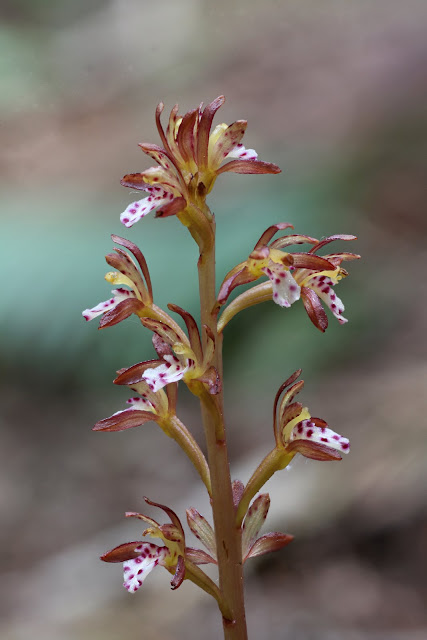These are some of my natural history ramblings, both literary and afoot, the result of a search for whatever there is to be found, including the native orchids and wildflowers of the beautiful state in which we live.
Wednesday, October 12, 2011
Three Orchids on the Goat Mountain Trail
I am way behind in blog posts, but I guess that gives me something to do over the winter months when there's not much hiking to be done. This post, then, goes back to the beginning of August, August 5th, to be exact. That afternoon for a few hours a friend and I went to do some hiking on the Goat Mountain trail in Mount Baker-Snoqualmie National Forest.
We did not go far enough on the trail - did not have enough time - to get out of the trees and into areas where we could view and photograph the surrounding mountains. We did see some interesting plants and wildflowers, however, and that is going to be the main subject of this post, though the light was not very good and photography was difficult.
The plants we saw, all under rather heavy forest cover, were primarily saprophytes. That name is no longer in common use as a result of further research on these plants, but I cannot remember what they are now called. These are plants without chlorophyll, leafless, and living off decayed matter in the soil through a sympiotic relationship with soil fungi.
One of these plants that seemed to be everywhere was Monotropa uniflora, Indian Pipes, also known as the Ghost Plant or Corpse Plant for obvious reasons. We also saw two saprophytic orchids, both Coralroots, though one of them was finished blooming. They were the Spotted Coralroot, Corallorhiza maculata var. maculata and the Early Coralroot, Corallorhiza trifida.
The Early Coralroot was finished blooming, but there were many nice clumps of them that we will have to go back and see next year when they are still blooming. We did see one other orchid in bloom that is not a saprophyte, however, the everywhere present Listera banksiana, the Northern Twayblade. I did not get the best pictures of it, so this will have to do.
One other plant, blooming everywhere, especially in damper areas, was the Long-tailed Ginger, Asarum caudatum. Unless you are looking for it or know what you are seeing, its flowers are not usually noticed since they lie on the ground under the leaves. Seeing them is always a treat since their color, long tails and unique shape are unmatched.
Subscribe to:
Post Comments (Atom)










8 comments:
What a treat to see these beauties growing in the wild! Thank you for sharing
Looks a lot like the spore producing structure of a plasmodial slime mold (myxomycota).
Thanks klaraau for the comments. WE so enjoy getting out and hiking, but for us at least the season is pretty well finished.
Thanks, Justin, for the id. I'll do some looking but I had no idea at all what it was. Really appreciate your taking the time to look at the post.
I actually follow the blog since I'm interested in native orchids, so thank you for posting.
It is nevertheless appreciated, Justin.
Dont you love ginger. I always delight when I can find a well formed flower. I cannot resist rubbing the leaves and sniffing my fingers.
August is pretty late for good coralroot, this must have been a well sheltered spot.
marti
Marti, August is indeed late, but when we were up on the Goat Mountain Trail the upper end of the trail was still impassable because of snow. We were on the Skyline Divide Trail two weeks later and it had only just opened. They never opened Artist's Point on Mount Baker this year and there are 30 feet of snow still there in some areas. Many of the higher trails are still impassable.
Post a Comment